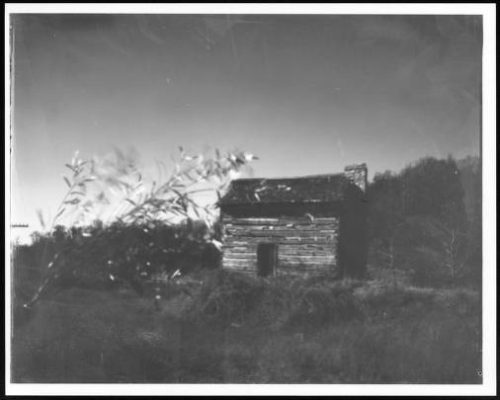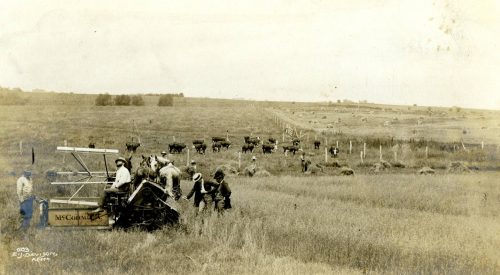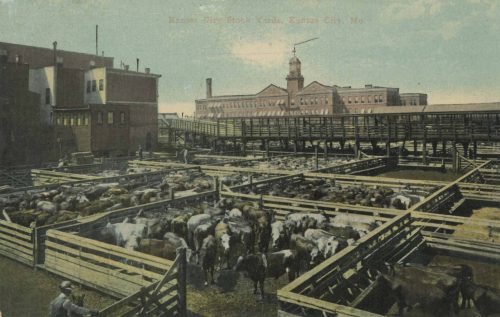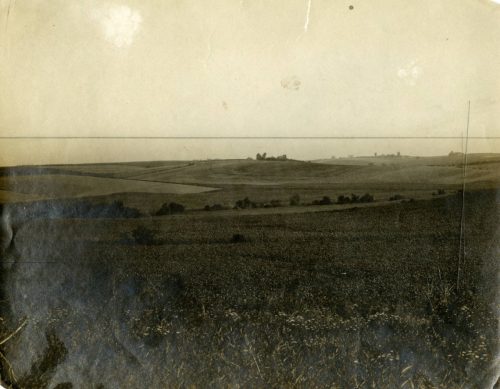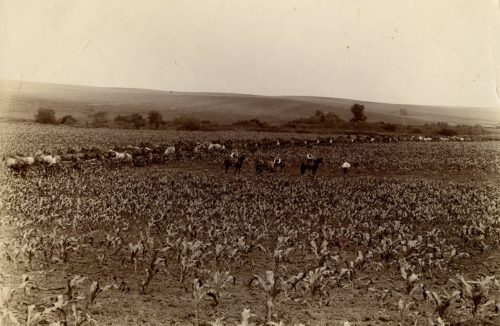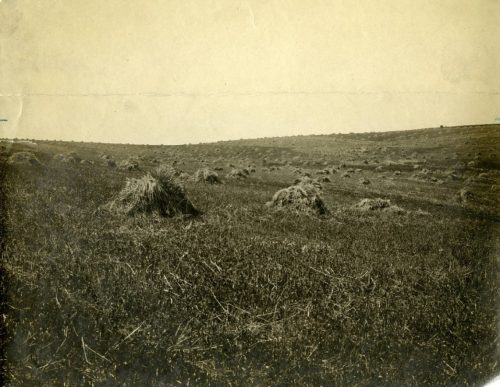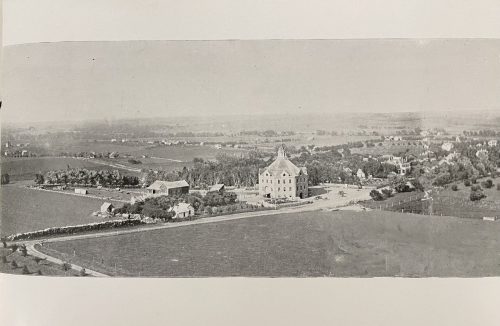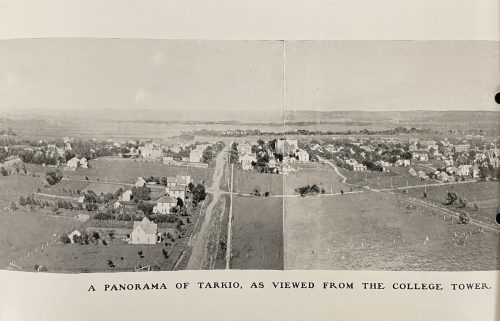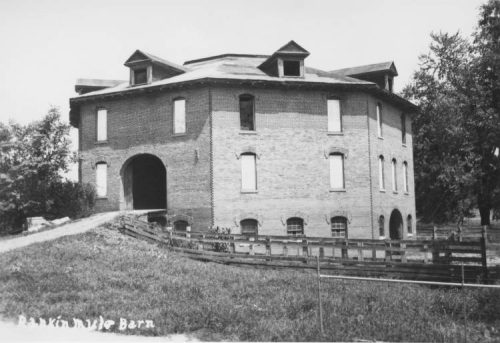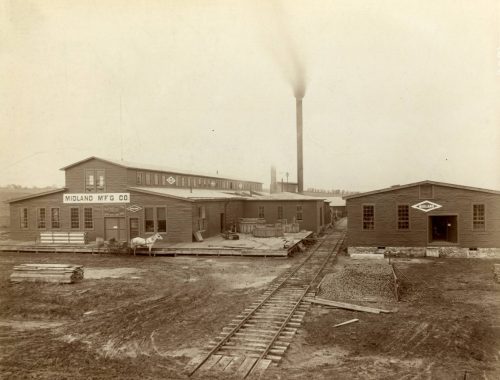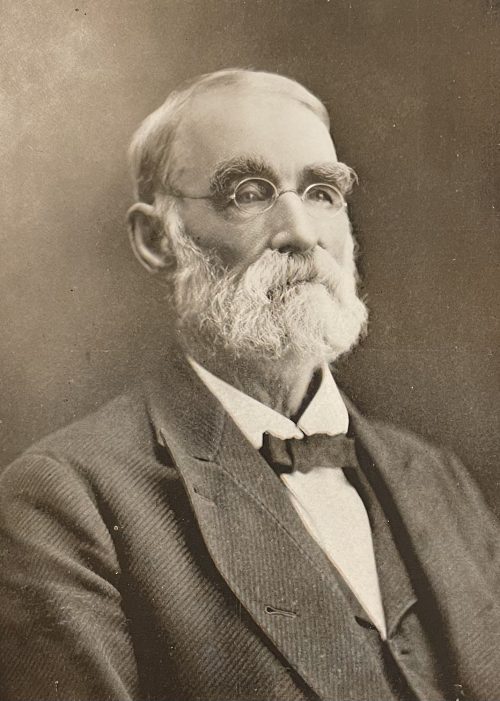![Rankin Headshot David Rankin, ca. 1882 [The History of Holt and Atchison Counties, Missouri, p. 922a. SHS REF F644 H629]](https://historicmissourians.shsmo.org/wp-content/uploads/2024/08/Rankin-Headshot-250x350.jpg)
David Rankin
Introduction
David Rankin was a farmer and businessman in Tarkio, Missouri. Called the “Cattle King” and “Corn King” for the size of his farming operations in Indiana, Illinois, Nebraska, and Missouri, Rankin made great use of machinery and new methods in farm management to build a business worth millions of dollars. The success of his farms played a part in changing the nature of farming in the United States in the nineteenth and early twentieth centuries.
Early Years
David Rankin was born in Sullivan County, Indiana, on May 28, 1825, to William Rankin and Elizabeth Gross Rankin. Growing up in a poor farming family, he moved with his parents and siblings to farms in Indiana and Illinois. Later in life, Rankin noted that since his family was too poor to afford shoes beyond a single pair in winter, he often traveled and worked barefooted. He was briefly a student in a local one-room schoolhouse but soon left it to join his father in working at a sawmill.
Farm Education
Despite these early hardships, David Rankin took up farming as a young adult and began looking for better and more profitable ways to farm. In 1847, he bought his first farm on eighty acres of land near Biggsville in western Illinois. Soon after, he married Sarah Thompson, who was originally from Guernsey County, Ohio. Not long after settling in Biggsville, he purchased a McCormick mechanical reaper, a new machine invented by Cyrus McCormick that allowed farmers to harvest grain at a faster rate. He also favored building windmills on his land to pump well water to the surface for his livestock to drink.
Rankin lived in Biggsville for nearly forty years. Though he did not serve in the Civil War in the 1860s, he sided with the Union and gave money to the war effort. After the war ended, he developed a business model that he followed for the rest of his life. In addition to raising crops and livestock, he used the nation’s growing railroad network to send his products to customers around the United States. When he turned a profit, he put his money into buying more land. His farming operations quickly grew from eighty acres to more than five thousand. Rankin is also credited, along with his cousin W. A. Rankin, with founding the town of Rankin, Illinois.
In 1872, Rankin ran for political office and was elected to the Illinois House of Representatives. He was reelected in 1874 but left the state government at the end of his second term in 1876, citing his wife’s health problems and the demands of managing his farming operations. Rankin did, however, win election to the Illinois House of Representatives once more in 1882 and served until 1884.
Rankin Live Stock Company
Though Rankin’s farming experience had mostly been in Indiana and Illinois, he began looking for land to the west in Nebraska and Missouri. In 1880, he established the Big Bar 7 Ranch near Seneca, Nebraska, where he raised cattle and shipped them by railroad to markets in the eastern United States. But the Rankin Live Stock Company, the official name given to the operations at the Big Bar 7 Ranch, drew complaints as nearby ranchers and homesteaders claimed the company illegally fenced in open range land and spread cattle diseases to other ranches. By the late 1880s, Rankin had moved his cattle to Missouri.
Atchison County
David Rankin’s relocation to Missouri began with a natural disaster. In the 1870s, Rankin was traveling through Iowa on his way to Texas when a major flood near Corning, Iowa, forced him to cancel his trip. He soon heard about available land just across the Iowa border in Atchison County, Missouri. He bought his first plot of land in Atchison County in 1876, but continued to live in Illinois for a few more years.
When he did move to Atchison County, he joined several members of his extended family, including three of his adult children, who had already settled on the land he had bought and helped establish the Missouri towns of Tarkio, Westboro, and Fairfax. The Rankins established banks in each town, including the First National Bank of Tarkio, and bought large amounts of land in Atchison County. In 1889, he partnered with J. M. Wolfe to build a steam-powered brick and tile factory as well as the Rankin Electric Light and Power Company in Tarkio. He also had a controlling interest in a telephone company and ice plant. In addition to his business interests, Rankin sought to bring entertainment and culture to Tarkio by building a twelve-hundred-seat auditorium next to the First National Bank.
Tarkio College
Not long after purchasing land in Missouri, the Rankins began backing a plan to move the Atchison County seat of government from Rock Port to Tarkio. To show his support for the plan, David Rankin constructed a building in Tarkio that could serve as the new courthouse. When the plan was rejected by county residents, the courthouse building instead was used for the new Tarkio Valley College and Normal Institute (later called Tarkio College).
Though he had received a limited education growing up, Rankin became a strong supporter of Tarkio College. After the main building burned down in 1892, he made a sizable donation to establish a new campus. After his death, Rankin left a large portion of his estate to Tarkio College .
Rankin Mule Barn
In the 1890s, near his home on the outskirts of Tarkio, Rankin built a four-story barn that was reported to be the largest in Missouri at that time. Called the Rankin Mule Barn, the building had eight sides. It housed stalls for horses and mules on the first floor, wagons and carriages as well as a workshop on the second floor, harnesses and other equipment on the third floor, and hay on the fourth floor. In 1907, the barn caught fire, forcing Rankin to rebuild portions of it, and the new additions included living quarters for farm laborers.
After it was no longer in use as a barn, Tarkio College converted the building into the Mule Barn Theatre for stage productions, and the second floor later became the Mule Barn Museum. The Rankin Mule Barn was added to the National Register of Historic Places in 1970 but was destroyed by fire in 1989.
Agricultural Innovator
A strong believer in new farming techniques and agricultural machinery, David Rankin also became a pioneer in his own right. He tried new forms of crop rotation, switching out corn for clover and grain in certain fields on a yearly basis alongside grazing cattle and hogs on the land as a way to replenish the ground. Many educators and farmers studied his uses of fertilizer and methods of soil conservation.
He also had an idea for a two-row plow, which eventually led to the start of the Rankin Manufacturing Company, later called Midland Manufacturing Company. Headquartered in Tarkio, the company produced a variety of farm equipment, including the two-row plow, windmills, pumps, hay stackers, and manure spreaders. The company sold and shipped so many products that an extra railroad track was built to connect the factory to the Tarkio Valley line of the Chicago, Burlington and Quincy Railroad. Rankin’s two-row plow was one of the inventions recognized and honored at the 1904 Louisiana Purchase Exposition in St. Louis.
Legacy
At the turn of the twentieth century, Rankin still managed the day-to-day operations of his various businesses. He insisted his hired workers observe Sunday as a day of rest and emphasized temperance, which meant not consuming alcohol. Near the end of his life, an inventory of Rankin’s land, livestock, farming operations, and real estate was valued at a total of $3,500,000 (or more than $100 million in today’s dollars). Due to the size of his agricultural investments, including tens of thousands of acres of land across the Midwest, national publications referred to Rankin as the “Cattle King,” “Corn King,” and the “richest farmer in the world.”
In 1910, David Rankin’s second wife, Elizabeth Phillips Gowdy, who he married in 1880, died. Only weeks later, David Rankin passed away on October 18, 1910. His memorial service was held at Tarkio College, and he was buried at Tarkio Home Cemetery. In 1931, Tarkio College honored their most prominent supporter by opening David Rankin Hall, a new building housing a library, offices, and classrooms.
Text and research by Sean Rost
References and Resources
For more information about David Rankin’s life and career, see the following resources:
Society Resources
The following is a selected list of books, articles, and manuscripts about David Rankin in the research centers of The State Historical Society of Missouri. The Society’s call numbers follow the citations in brackets.
Articles from the Newspaper Collection
- “Cattle Feeding in Northwest Missouri.” St. Louis Globe-Democrat. July 9, 1899. p. 1.
- “David Rankin, Farmer.” Kansas City Star. June 30, 1901. p. 13.
- “Hon. David Rankin Passes Away After Brief Illness.” Tarkio Avalanche. October 20, 1910. p. 1.
- “Last Tributes to David Rankin.” Tarkio Avalanche. October 27, 1910. p. 1.
- “Missouris’ Farm of 23,000 Acres.” St. Joseph Gazette. August 28, 1904. p. 8.
- Caldwell, Dorothy J., “David Rankin: ‘Cattle King’ of Missouri,” Missouri Historical Review 66, no. 3 (April 1972), 377-394. [REF F550 M691]
- Craig, Cathryn Coe. Tarkio College, 1883 to 1992: An Illustrated History of “The Crown of the Hill.” Rock Port: Family First Publications, 1992. [REF 378.778T1 E2]
- Rankin, David. David Rankin, Farmer: Modern Agricultural Methods contrasted with Primitive Agricultural Methods by the Life History of a Plain Farmer. Tarkio: N.P., 1909. [REF F508.1 R167]
- Schoenfelder, John F. and Robert Allen Rankin Jr. From His Toil and the Soil: David Rankin of Tarkio, Missouri; Cultivating 24,000 Acres behind Mules made him America’s Biggest Farmer ca. 1900. N.P.: Published by the authors, 2015. [REF F508.1 R167sch]
- Summers, Florence. David Rankin: True Story of an American Gentleman. St. Louis: Concordia Seminary, 1957. [REF F508.1 R167s]
- Tarkio College. Tarkio College Calendar, 1901-1902. [REF 378.778T1]
- Tarkio College. Tarkio College Calendar, 1902-1903. [REF 378.778T1]
- Tarkio College. Tarkio College Phoenix. Kansas City: Press of Hudson-Kimberly Publishing Company, 1896, 1898-1899, 1900-1901, 1902, 1906, 1916. [REF 378.778T1 Q2]
- The History of Holt and Atchison Counties, Missouri: containing a history of these counties, their cities, towns, etc., etc., biographical sketches of their citizens, general and local statistics, portraits of early settlers and prominent men, history of Missouri, map of Holt and Atchison counties, etc. St. Joseph: National Historical Company, 1882. [REF F644 H629]
- Missouri Mule History Project (C3954)
Records produced by a University of Missouri project to document the history of the state’s mule industry, consisting of oral history recordings and transcripts of interviews with men and women concerning their experiences with the Missouri mule, project produced publications, and promotional materials. Folder 92/a.c. 93 contains an oral history with Robert Rankin about David Rankin and the family’s history in northwest Missouri.
Outside Resources
These links will take you outside the Society’s website. The Society is not responsible for the content of the following websites:
- Illinois Digital Newspaper Collections
This website is hosted by the University of Illinois and features an article, “David Rankin’s Success as a Cattle Feeder and Corn Grower,” which was featured in the April 22, 1904, edition of Wallace’s Farmer. - Project Muse
This website is hosted by Project Muse, a consortium of university presses and scholarly societies, and features an academic article from the Great Plains Quarterly written by Jason Combs, “David Rankin: America’s Greatest Farmer.”

